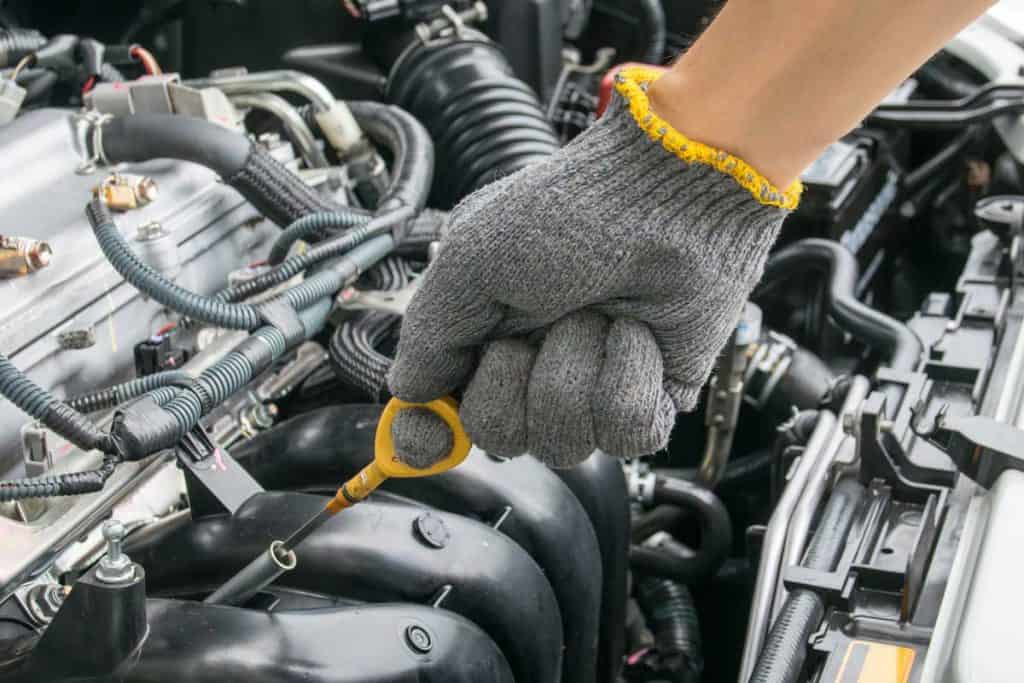 Your car’s engine relies on engine oil for optimal performance. But, adding too much or too little oil can damage the engine over time. If you frequently check your car's oil level or are preparing for a DIY oil change, you might be wondering how much oil your vehicle needs.
Your car’s engine relies on engine oil for optimal performance. But, adding too much or too little oil can damage the engine over time. If you frequently check your car's oil level or are preparing for a DIY oil change, you might be wondering how much oil your vehicle needs.
A typical 2.4L car engine will require between 4 and 6 quarts of oil. Larger engines (pick-up trucks and diesel vehicles) can require up to 8 quarts of oil. The amount of oil your car needs depends on a few critical factors:
- Engine Size
- Manufacturer’s Recommendations
- Oil Filter Change - If you plan to change the oil filter, it can affect the total amount of oil you add because the filter can hold between 1/4 to 1/2 quart of oil.
Using these factors, you can determine how much oil is needed for your car. Keep reading, and we'll explain how to assess engine size, where to find the manufacturer's recommendations, and what using too much or too little oil means for the engine's longevity and function.
How Does Engine Size Affect the Amount of Oil My Car Needs?
The amount of oil your car needs primarily depends on the size of the engine. Generally, the larger the motor, the more oil it will need.
Engines rely on oil to run smoothly. Oil lubricates a running engine’s moving components, to decrease friction. Less friction means the engine runs cooler, thus preventing the engine from overheating. Oil also helps to keep an engine clean by removing deposits or other contaminants from the engine’s components.
Smaller, 4-cylinder (2.4L) car engines typically need 4 to 5 quarts of oil. A 6-cylinder (V6) engine needs up to 6 quarts of oil. An 8-cylinder (V8) engine, commonly found in larger pick-ups and diesel-powered vehicles, requires as little as 5 quarts to as much as 8 quarts of oil.
Engine oil volume will vary depending on your car’s manufacturer. Ford’s 3.5L EcoBoost (V6) engine uses 6 quarts of oil (including oil filter). Toyota’s 2GR-FE 3.4L (V6) uses 6.2 quarts of oil (including oil filter). It is important to always follow the manufacturer’s recommendations for the correct amount of oil in your car, as either too little or too much oil can cause your car’s engine to wear.
If you are not sure about the size of your car’s engine, you can quickly determine the engine size by:
- Checking the ‘Vehicle Specifications’ section of your owner’s manual.
- Looking under the hood (make sure the engine is OFF!) to find an EPA sticker or etched marking that indicates the engine size.
- Copying your car’s VIN, located on the driver’s side dash, and search the VIN online by using a website such as VINCheck.info to determine your car’s make/model/engine size.
Where Can I Find Manufacturer’s Recommendations for Oil?
We’ve already stressed the importance of following the manufacturer’s recommendations for your car but, if you do not have an owner’s manual, there are other ways to obtain this vital information.
Go online. Most vehicle manufacturers’ websites provide an owner’s section where you can find owner’s manuals, maintenance schedules, warranty information, and how-to guides. Visit the site (such as owners.honda.com) and be prepared to enter either the year and model of your car or to enter your car’s VIN for the most accurate results.
Go to the experts. Mechanics at most car service centers can answer specific questions about your car. Service centers maintain extensive databases of vehicle specifications so, if the mechanic cannot provide the answer from experience, he or she can search the database to determine what the manufacturer recommends for your car.
How to Check the Oil Level?

Whether you are topping-up or replacing the oil in your car, you should first check the car’s oil level by using the dipstick. Your owner’s manual will provide instructions on how to locate and accurately read the dipstick.
Warm up the engine by running it for approximately 5 to 10 minutes before you check the oil level. Warming the engine helps to circulate the oil through all the engine’s components. After turning the engine off, let it rest for approximately 2 to 5 minutes to allow the remaining oil to settle into the crankcase.
Pull the dipstick from its port and wipe the end of the stick with a clean cloth. Reinsert the dipstick into is port and wait a few seconds before pulling the dipstick out again. Pull the dipstick and look to see where the oil level falls on the dipstick’s markings. The lower end, near the bottom of the dipstick, marks a low or minimum oil level. The upper end, toward the top of the dipstick, marks a full or maximum oil level.
If the dipstick indicates a low or minimum oil level, add more oil and wait approximately 2 minutes before rechecking the dipstick. Remember, if you have also changed the oil filter, your car may hold 1/4 to 1/2 quart more oil than you anticipate. Most manufacturers will provide oil filter capacity in the owner’s manual.
Continue to slowly add oil and recheck the dipstick to ensure you have added the correct amount. If you accidentally overfill the oil, a few millimeters would be alright. But, if you overfill by 1/2 quart or more, we recommend you drain the excess oil.
What Happens if I Put Too Much Oil in My Car?
You do not have to worry if your car’s oil dipstick reads a few millimeters higher than the full or maximum level indicator. But, will an extra quart of oil hurt? The answer is yes. Excess engine oil can result in severe wear or damage to your car’s engine.
The crankshaft, oil pump, and mechanical engine components will whip any excess oil into a frothy mixture. Frothy oil contains air bubbles. When frothy oil circulates throughout the engine, those air bubbles hinder the oil’s ability to lubricate the engine’s moving components properly. Increased friction can result, causing wear to the engine's components over time.
Will Your Car Smoke if You Put Too Much Oil In?
White smoke from the engine or exhaust can indicate that your car’s engine has too much oil. Excess, escaping oil can easily burn when it comes into contact with hot engine components. If you observe smoke coming from your engine or exhaust, consult a mechanic immediately to diagnose the problem.
What Happens if I Put Too Little Oil in My Car?
Measuring your car’s oil level is not an exact science, so do not worry if the dipstick reads a few millimeters below the low or minimum indicator. Driving a car with too little oil in the engine, however, let’s say 1/2 a quart less than the manufacturer’s recommendation, can result in damage to the engine over time.
Less oil in the engine means there is more friction between the engine’s moving components. Your engine has a higher chance of overheating when there is more friction. In the long run, too little oil can lead to excess wear on the engine’s components.
How Much Oil Does My Car Need if it’s Empty?
Check the manufacture’s recommendations in your owner’s manual for the amount of oil your car needs and the oil filter’s capacity.
Why is there no oil on the dipstick? If your car’s oil level is empty and does not reach the dipstick, you should add at least one (1) full quart of oil immediately. Recheck the dipstick. Continue to add oil and recheck the dipstick until the oil reaches an appropriate level.
Can I Just Add a Quart of Oil to My Car?
Most vehicle manufacturers recommend you check the oil at least once a month. Follow the scheduled maintenance recommendations in the owner’s manual for your car.
Do not just add a quart of oil. First, check the dipstick to read the oil level. If the oil is low, slowly add oil and recheck the dipstick until the oil level reaches an appropriate amount.
Depending on your car’s make/model, you might have an indicator light to notify you of low oil levels. If the indicator light is aglow, check the dipstick and add oil accordingly.
If you drive a battery-powered electric vehicle (EV), you will never have to add oil to your car because EV engines do not have moving parts that require lubrication. Check your owner’s manual for any other EV maintenance.
Why Does My Car Go Through Oil So Fast?
Most engines with fewer than 50,000 miles should not use more than one (1) quart of oil between oil changes. Vehicle manufacturers can tell you what is considered normal for your engine’s oil usage. If you are now wondering, why is my car losing oil but there is no leak, there might be another culprit.
As engines age and wear, they consume more engine oil. Engine components such as worn seals, piston rings, or valve stems are areas where slight amounts of oil can escape and come into contact with combustion chambers. Slight amounts of escaped oil burn off, and you might only notice this over time as a lower read of the oil level on your car’s dipstick.
If your car’s engine is consuming more than the normal range of oil between oil changes, you should consult a mechanic to diagnose the problem. Burning oil in the engine’s combustion chamber is problematic for your engine over time. You might also notice a blue tinge on the exhaust smoke, a sure sign of burning oil.
Now that you know how to determine how much oil your car needs and the importance of just the right amount, you can easily maintain your car's oil level for optimal engine performance.

The News and Announcements you share are very up to date. I would love to read this news.
Thanks for sharing this news..
The content is presented in a clear and concise manner, making it easy for readers to understand and implement the information. The inclusion of step-by-step instructions and helpful tips enhances the overall user experience, ensuring that both novice and experienced car owners can benefit from the article. I particularly appreciate how the article addresses different factors that can influence oil consumption, such as the type of engine and driving conditions, providing a well-rounded perspective. This resource is a valuable tool for car enthusiasts and owners alike, empowering them to take better care of their vehicles and ensure optimal performance.